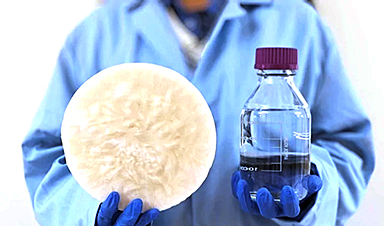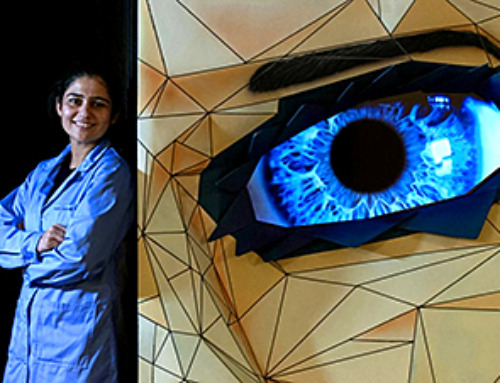UT Austin researchers have developed a biodegradable, biomass-based hydrogel that efficiently extracts drinkable water from the air, offering a scalable, sustainable solution for water access in off-grid communities, emergency relief, and agriculture.
Discarded food scraps, stray branches, seashells, and other natural materials serve as key ingredients in a new system developed by researchers at The University of Texas at Austin that can extract drinkable water from thin air.
This innovative system, called “molecularly functionalized biomass hydrogels,” transforms a wide range of natural products into sorbents—materials that absorb liquids. By pairing these sorbents with mild heat, the researchers can extract gallons of drinkable water from the atmosphere, even in arid conditions.
“With this breakthrough, we’ve created a universal molecular engineering strategy that allows diverse natural materials to be transformed into high-efficiency sorbents,” said Guihua Yu, a professor of materials science and mechanical engineering and Texas Materials Institute at UT Austin. “This opens up an entirely new way to think about sustainable water collection, marking a big step towards practical water harvesting systems for households and small community scale.”
In field tests, the researchers generated 14.19 liters (3.75 gallons) of clean water per kilogram of sorbent daily. Most sorbents can generate between 1 and 5 liters per kilogram per day.
The new research was published in Advanced Materials.
Turning Biomass into High-Efficiency Sorbents
This system represents a new way of designing sorbents, the researchers say. Instead of the traditional “select-and-combine” approach, which requires picking specific materials for specific functions, this general molecular strategy makes it possible to turn almost any biomass into an efficient water harvester.
Unlike existing synthetic sorbents, which use petrochemicals and generally require high energy inputs, the UT Austin team’s biomass-based hydrogel is biodegradable, scalable, and requires minimal energy to release water. The secret lies in a two-step molecular engineering process that imparts hygroscopic properties and thermoresponsive behavior to any biomass-based polysaccharide, such as cellulose, starch, or chitosan.
“At the end of the day, clean water access should be simple, sustainable, and scalable,” said Weixin Guan, a senior doctoral student and the study’s lead researcher. “This material gives us a way to tap into nature’s most abundant resources and make water from air—anytime, anywhere.”
The latest innovation is part of Yu’s years-long quest to develop solutions for people lacking access to clean drinking water. He’s developed water-generating hydrogels throughout his career, adapting them for the driest conditions. He recently created an injectable water filtration system, and he has applied his hydrogel technology to farming.
The research team is now working on scaling production and designing real-world device systems for commercialization, including portable water harvesters, self-sustaining irrigation systems, and emergency drinking water devices. Since the beginning, the researchers have focused on scalability and the ability to translate this research into solutions that can help people around the world.
“The biggest challenge in sustainable water harvesting is developing a solution that scales up efficiently and remains practical outside the lab,” said Yaxuan Zhao, a graduate researcher in Yu’s lab. “Since this hydrogel can be fabricated from widely available biomass and operates with minimal energy input, it has strong potential for large-scale production and deployment in off-grid communities, emergency relief efforts, and decentralized water systems.”
Reference: “Molecularly Functionalized Biomass Hydrogels for Sustainable Atmospheric Water Harvesting” by Weixin Guan, Yaxuan Zhao, Chuxin Lei, Yuyang Wang, Kai Wu and Guihua Yu, 13 February 2025, Advanced Materials.
DOI: 10.1002/adma.202420319
News
Scientists May Have Found a Secret Weapon To Stop Pancreatic Cancer Before It Starts
Researchers at Cold Spring Harbor Laboratory have found that blocking the FGFR2 and EGFR genes can stop early-stage pancreatic cancer from progressing, offering a promising path toward prevention. Pancreatic cancer is expected to become [...]
Breakthrough Drug Restores Vision: Researchers Successfully Reverse Retinal Damage
Blocking the PROX1 protein allowed KAIST researchers to regenerate damaged retinas and restore vision in mice. Vision is one of the most important human senses, yet more than 300 million people around the world are at [...]
Differentiating cancerous and healthy cells through motion analysis
Researchers from Tokyo Metropolitan University have found that the motion of unlabeled cells can be used to tell whether they are cancerous or healthy. They observed malignant fibrosarcoma cells and [...]
This Tiny Cellular Gate Could Be the Key to Curing Cancer – And Regrowing Hair
After more than five decades of mystery, scientists have finally unveiled the detailed structure and function of a long-theorized molecular machine in our mitochondria — the mitochondrial pyruvate carrier. This microscopic gatekeeper controls how [...]
Unlocking Vision’s Secrets: Researchers Reveal 3D Structure of Key Eye Protein
Researchers have uncovered the 3D structure of RBP3, a key protein in vision, revealing how it transports retinoids and fatty acids and how its dysfunction may lead to retinal diseases. Proteins play a critical [...]
5 Key Facts About Nanoplastics and How They Affect the Human Body
Nanoplastics are typically defined as plastic particles smaller than 1000 nanometers. These particles are increasingly being detected in human tissues: they can bypass biological barriers, accumulate in organs, and may influence health in ways [...]
Measles Is Back: Doctors Warn of Dangerous Surge Across the U.S.
Parents are encouraged to contact their pediatrician if their child has been exposed to measles or is showing symptoms. Pediatric infectious disease experts are emphasizing the critical importance of measles vaccination, as the highly [...]
AI at the Speed of Light: How Silicon Photonics Are Reinventing Hardware
A cutting-edge AI acceleration platform powered by light rather than electricity could revolutionize how AI is trained and deployed. Using photonic integrated circuits made from advanced III-V semiconductors, researchers have developed a system that vastly [...]
A Grain of Brain, 523 Million Synapses, Most Complicated Neuroscience Experiment Ever Attempted
A team of over 150 scientists has achieved what once seemed impossible: a complete wiring and activity map of a tiny section of a mammalian brain. This feat, part of the MICrONS Project, rivals [...]
The Secret “Radar” Bacteria Use To Outsmart Their Enemies
A chemical radar allows bacteria to sense and eliminate predators. Investigating how microorganisms communicate deepens our understanding of the complex ecological interactions that shape our environment is an area of key focus for the [...]
Psychologists explore ethical issues associated with human-AI relationships
It's becoming increasingly commonplace for people to develop intimate, long-term relationships with artificial intelligence (AI) technologies. At their extreme, people have "married" their AI companions in non-legally binding ceremonies, and at least two people [...]
When You Lose Weight, Where Does It Actually Go?
Most health professionals lack a clear understanding of how body fat is lost, often subscribing to misconceptions like fat converting to energy or muscle. The truth is, fat is actually broken down into carbon [...]
How Everyday Plastics Quietly Turn Into DNA-Damaging Nanoparticles
The same unique structure that makes plastic so versatile also makes it susceptible to breaking down into harmful micro- and nanoscale particles. The world is saturated with trillions of microscopic and nanoscopic plastic particles, some smaller [...]
AI Outperforms Physicians in Real-World Urgent Care Decisions, Study Finds
The study, conducted at the virtual urgent care clinic Cedars-Sinai Connect in LA, compared recommendations given in about 500 visits of adult patients with relatively common symptoms – respiratory, urinary, eye, vaginal and dental. [...]
Challenging the Big Bang: A Multi-Singularity Origin for the Universe
In a study published in the journal Classical and Quantum Gravity, Dr. Richard Lieu, a physics professor at The University of Alabama in Huntsville (UAH), which is a part of The University of Alabama System, suggests that [...]
New drug restores vision by regenerating retinal nerves
Vision is one of the most crucial human senses, yet over 300 million people worldwide are at risk of vision loss due to various retinal diseases. While recent advancements in retinal disease treatments have [...]





















